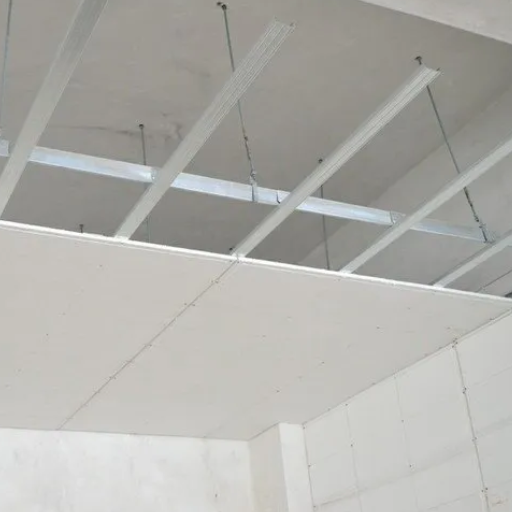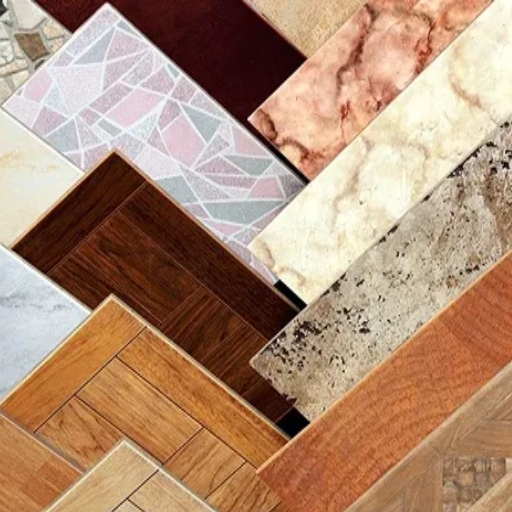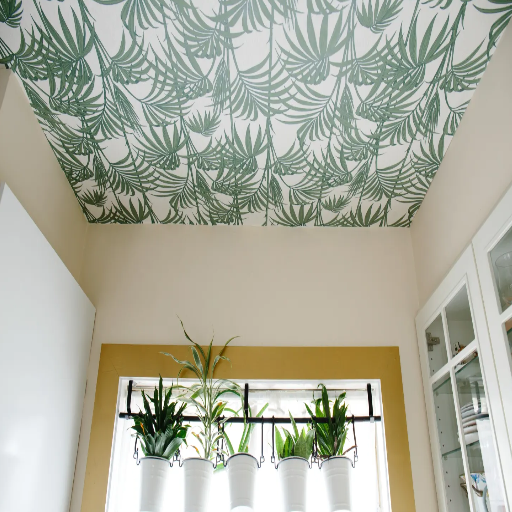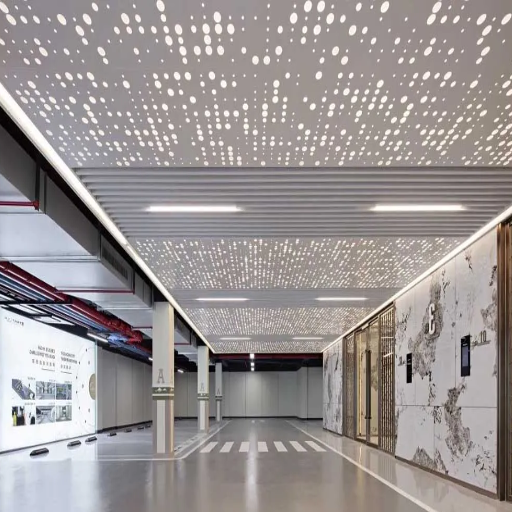Ceilings are among the last places requiring more attention while making an architectural structure. However, picking the right ceiling board could improve your interior space’s functionality, aesthetics, and value. This article analyses the best reasons for acquiring premium ceiling boards, which range from improving almost every structural component in your home, including insulation and acoustic performance, to providing beautiful designs. Whether you are working on a renovation or a new construction project, understanding the impact of this critical choice will set you on the right path to achieving an appealing and captivating living space. Read more to find out how premium ceiling boards can transform spaces for the better. Find more info now!
What Are the Advantages of Using Gypsum Ceiling Panels?
Durability and Moisture Resistance of Gypsum
Both residential and commercial applications benefit from the continuous durability of gypsum ceiling panels. As is the case with most panels, they are built to last without compromising on quality and can withstand daily wear and tear for a long time. One of the features that sets gypsum panels apart from other products is their resistance to moisture. While traditional materials warp and deteriorate with humidity, gypsum panels actively maintain their structural integrity even when the conditions are damp.
This moisture-resistant trait is ideal for high-humidity-prone regions like the bathroom, kitchen, or basement. To guarantee the panels remain stable and do not sag or develop mold, silicone is added to the gypsum panel mix to drastically improve the resistance to water absorption. Many manufacturers provide standardized moisture-resistance ratings, allowing users to choose panels tailored for specific environments. With unmatched moisture resistance and concomitant durability, gypsum ceiling panels can be used in modern spaces.
Acoustic Properties of Gypsum Ceiling Panels
Gypsum ceiling panels are used in residential and commercial buildings due to their aesthetic value and good acoustic properties. These panels help in sound absorption and attenuation, improving the acoustic performance in the target space. Gypsum, being a mineral, has some sound attenuation properties, and when used with perforations or other added acoustic laminates, the panels can achieve an even higher level of sound insulation.
Perforated gypsum panels have been shown to achieve an NRC rating of 0.6 to 0.8 depending on design and installation. This means these panels can absorb almost 80 percent of sound in the specified area. It is also noted that some gypsum panels have been manufactured with added sound-damping layers, which help block airborne noises like voices or music, thus making the area more private and comfortable. These exceptional qualities of gypsum panels make them highly suitable for use in theaters, offices, classrooms, and conference rooms where there is a need to control acoustics. Controlling disruption while enhancing clarity is a key architectural consideration, and incorporating gypsum panels in construction provides a solution. Modern designs often forget the functional aspect while focusing on aesthetic beauty, but with gypsum, there is a way to achieve both.
Cost Analysis of Using Gypsum Boards for Residential Construction
Gypsum boards are gaining popularity among homeowners due to their economical nature, durability, and functionality. A few primary aspects determine their cost-effectiveness, such as low production cost and ease of installation. They are extraordinarily lightweight, which significantly reduces transportation and handling costs. Moreover, they permit rapid installation, reducing labor costs due to the high variable costs associated with plastering.
Their energy-efficient properties allow further long-term savings. When adequately insulated, these boards regulate indoor temperatures, thus considerably lowering heating and cooling costs. These attributes make it attractive for customers aiming to control expenses while ensuring comfort. In addition, these boards need little maintenance as they are fire, mold, and pest-resistant, allowing them to last and significantly reduce the need for repairs. Offering affordable yet high-performance solutions enables gypsum boards to remain at the forefront of the residential construction industry.
How Do I Choose the Right Ceiling Tile Material?
Analyzing Gypsum versus Mineral Fiber Ceiling Tiles
It is essential to know the features, advantages, and uses of mineral fiber and gypsum ceiling tiles to help make an informed decision.
Gypsum Ceiling Tile has a unique smooth surface finish that is stylish, polished, and highly suitable for residential and commercial interiors. They are aesthetically pleasing and provide adequate thermal insulation, helping maintain indoor comfort and great acoustic noise reduction. Furthermore, these tiles are fireproof and extremely tough, making them excellent for long-term, low-maintenance use. Due to their sleek and contemporary design, these tiles are primarily used in offices, hospitals, and private residential rooms.
In contrast, conference rooms, classrooms, and theaters that require minimal noise interference often use spaces that use Mineral Fiber Ceiling Tiles due to their sound absorption characteristics. They can be considered an environmentally friendly option, as they are made from recycled wood fiber, fiberglass, and mineral wool. Other advantages of mineral fiber tiles are their lightweight nature, low price, design flexibility, and various graphics and textures. Unfortunately, their noise absorption features come at a cost. Unlike gypsum tiles, they are more brittle, meaning more care needs to be put into handling them, as they are more susceptible to moisture and impact damage.
When choosing between these materials, essential considerations include the level of required acoustic control, preferred aesthetics, outer elements’ durability, and costs. Gypsum shows higher marks for durability and fire resistance, while mineral fiber tiles mark higher for sound features and environmentally friendly production. The two materials are uniquely different in terms of features targeted for specific uses, allowing customers to choose according to their design and spatial requirements.
Benefits of PVC and Wood Ceiling Tiles
Both PVC and wood ceiling tiles come with their benefits, which differ based on the project’s requirements. Ceiling tiles made from PVC are exceptionally light and durable, making them ideal for bathrooms and kitchens since they are moisture-prone. PVC ceiling tiles are virtually maintenance-free, unlike wood tiles, which eventually warp, crack, and discolor over time. They also come in a wide range of colors and designs, which can create esthetically pleasing environments without compromising building performance.
Wood ceiling tiles, on the other hand, bring unmatched natural beauty and elegance to interiors. While having a rustic appeal, they also require more care and attention than PVC tiles. However, newer treated wood materials make them more resilient to moisture in controlled environments. These tiles are also much more expensive than other options because they are considered a premium choice and are crafted using natural materials.
In the end, choosing between PVC and wood ceiling tiles requires balancing your budget, design, and surrounding environmental conditions. Both wood ceiling tiles and PVC tiles boast striking aesthetics; however, the latter has the upper hand in cost, moisture management, and maintenance.
Factors to Consider for Acoustic Ceiling Tile Installation
Multiple variables related to performance and longevity must be considered when planning the installation of an acoustic ceiling tile. The first item you must assess is the space’s acoustic needs. In an office, school, or auditorium, tiles with a more significant Noise Reduction Coefficient (NRC) will help with reverberation. In meeting rooms, tiles with a higher Sound Transmission Class (STC) rating will help in more discreet environments.
Your next consideration will undoubtedly focus on the site’s physical and atmospheric conditions. Your ceiling grid system should be able to support the tile weight, and the surrounding area should be examined for moisture problems that might damage certain materials. Areas susceptible to high humidity, such as basements or kitchens, would benefit from mold-resistant acoustic ceiling tiles.
Aesthetic taste and practicality must also influence your decision. Modern acoustic tiles come in various textures, finishes, and designs, which can be tailored to match the room’s style. In an industrial or commercial context, tiles with added value features like fire protection or thermal insulation may be more helpful.
As already mentioned, effective installation has a considerable effect on performance. Careful measurement, alignment, and fastening of the tiles to the surface are necessary to soundproof or deafen the area. More frequent routine maintenance, like cleaning and checking the tiles, prolongs the life of acoustic ceiling tiles and helps them receive the most value.
What Are the Best Ceiling Tiles by Color for Home Design?
Color Innovations That Are Most In Demand For Ceiling Tiles In Homes
When designing a house, choosing the tone for ceiling tiles significantly influences the room’s mood. White cream and light gray are still preferred for contemporary homes as they are neutral shades that withstand time. These colors complement various interiors, from simple to classic styles.
In addition, builders are increasingly focusing on using warmer and richer colors, such as beige, taupe, or brownish soft hues. These are especially effective for living rooms and bedrooms because they make the rooms more warm and welcoming. On the other hand, contemporary-styled spaces or industrial-themed rooms are being designed using bold colors such as dark gray and black, but these colors should only be applied in rooms with significant space and natural light to avoid closing in the room.
For the more daring, muted navy blue, forest green, and burgundy ceiling tiles are getting more attention in bold interior designs. These colors tend to contrast beautifully with more neutral-painted walls, adding a rich feel to the room. The beauty of these colors is further enhanced with the subtle addition of gold or silver metallic accents.
Ceiling tiles are becoming more tailored to the atmosphere a homeowner wishes to create, which combines personal tastes with modern design fads. From more basic options to more audacious ones, the chosen colors for ceiling tiles can significantly alter the feel of a space, enhancing its visual impact.
How Colors Associated with Ceiling Panels Affect The Atmosphere in A Room
In general, color has an intimate significance in decor, impacting how people in a given area interact with and utilize the space. Light colors such as white, cream, yellow, and light variations of pastel can foster a breezy feeling, heightening the illumination in small areas. They can increase the light in an area, which usually makes a good impression on a room. In contrast, combining deep hues like dark blue, gray, or black can enhance the sense of dramatic decor and can come across as warm for a dining room or home theater. This gives these areas a cozy yet sophisticated feel.
Research shows that warm hues, such as yellow or earthy red, can capture attention more efficiently, unlike softer colors like green or blue, which help soothe the mind. Ceiling panel colors can complement or contrast the wall colors, the furniture in the room, or other decorations, enhancing striking centerpieces or simple basic designs.
Additionally, mixing patterned or textured ceiling panels with occasional appropriate color choices enhances and transforms the room’s character and/or soul.
For example, combining metal accents and darker colors can produce a sophisticated modern look, while applying colors in the gradient can give a moderate yet energetic visual appeal. The blank canvas that ceiling panels offer is nearly boundless. The innumerable possibilities of textures and colors available enable customizability, giving designers and homeowners room to achieve their aesthetic desires and functional needs.
Matching Ceiling Tiles with Home Decor
When harmonizing ceiling tiles with other adornments in the room, the style of the room, color scheme, and texture should be considered. Covered tile styles or tin finishes can resemble the beauty of traditional interiors and enhance the space by adding elegance for modern purposes. For simplistic, modernist spaces, flat, matte, neutral-styled tiles or those featuring geometrical designs can provide aesthetic cohesion to the surrounding space. Also, these rustic or industrial-styled rooms can use wood-textured tiles to give warmth and character to the space.
Sound-absorbing acoustic ceiling tiles are crucial for beauty and are beneficial for reducing noise in big open areas and entertainment rooms. Moreover, reflective ceiling tiles can make artificial and natural light from the windows brighter, creating an illusion of spaciousness and warmth in confined or dimmer spaces. A satisfactory balance can be achieved through the room’s decor by integrating the ceiling tiles with style elements and achieving a stunning and functional environment.
How to Install Drop Ceiling Tiles Effectively?
Step-by-Step Guide to Installing a Drop Ceiling
With adequate preparation, installing a drop ceiling becomes effortless. This is how I would do it:
Measure and Plan the Space: First, measure the room’s perimeter. With accurate dimensions of tiles, grid systems, and additional hardware, you will avoid any material expenditure issues. You are now to mark the ceiling’s height and make sure it is consistent throughout.
Install Wall Moldings: These define the area marked for the wall. Using screws or nails will allow you to mold them while keeping everything level.
Build the Ceiling Grid: Create openings 2×2 or 2×4 feet wide centrally to the leading runners, along with cross tees. Now, hang the grid from the joists using the hanger wires while keeping the grid at a consistent height from the joists.
Install the Ceiling Tiles: While the grid is secure, install the ceiling tiles by laying them into the grid openings. Edges and fixtures can be fitted on the tile’s borders.
Final Details: Light panels, vents, and any other decorative features can now be installed. Go around the entire ceiling and check its alignment and stability.
Professionals will find this approach efficient and rewarding. It provides the tools and measurements needed to make the job easier and more satisfying.
Tools and Materials Needed for Ceiling Tile Installation
Here’s how to gather tools and materials for excellent quality when installing ceiling tiles unlike any other, achieving precision and efficiency in the installation process.
Ceiling Tiles: Select tiles that fit your image and the size of the ceiling grid you previously set.
Measuring Tape: Tiles are most likely to be placed accordingly within the grid and accurate measurement ensures that.
Utility Knife or Tile Cutter: This is a must-have tool for creating seamless edges or other features.
Chalk Line: This tool serves a similar purpose as a string meter. It is great for drawing straight lines.
Adhesive or Screws: These tools will help in placing tiles in position, and they will provide reliable securement stemming from the withdrawal tension.
Grid Components (if needed): Drop ceiling installation requires specific tools, which are T bars, cross tees, and wall angles.
Level: It helps check the string grid or uniformity of the adhesive tiles.
Ladder or Scaffolding: Due to the height of the ceiling, it allows safe access and, therefore, aids in making improvements to the ceiling.
In sum, the installation procedure is more streamlined, which ensures professional and durable results when these tools and materials are prepared ahead of time.
Common Mistakes to Avoid During Installation
In my opinion, making mistakes when measuring or marking out the area’s boundaries is one of the most common errors that occur while installing a drop ceiling. Not making accurate measurements can lead to dead-aligned grid systems or ceiling tiles that are not correctly fitted, resulting in squandered time and materials. This can be prevented by ensuring all measurements are checked, and all reference points are marked before work begins. A laser level can also achieve enhanced accuracy and prevent uneven setups.
Mistakes made by utilizing the wrong type of fastener or other hardware for a specific type of ceiling structure or material are another major obstacle. A common mistake includes using screws or anchors which do not have the appropriate load rating when supporting the grid or tile system, resulting in compromised durability and safety of the installation. Always remember to install quality fasteners that correspond to the specifications given by the manufacturer. Also, check whether your ceiling tiles are acoustic, PVC, or any other type and are compatible with the grid system to ensure the tiles can withstand the test of time.
Finally, failing to pay careful attention to leveling can lead to problems regarding the appearance of the ceiling. Unlevel grids or unsquared tiles will always make the installation appear substandard. Allocating enough time to level every part while installing can be very productive. As the grid configuration is done, I suggest you periodically take a break and observe how the grid is formed during the exercises. Production at every step will provide a cohesive and refined look for the room, which is ultimately more pleasing to the eye.
What Are the Latest Trends in Ceiling Panel Design?
Creative Textures and Finishes for Ceiling Panels Innovations
My findings show that the design of ceiling panels has evolved from the more basic options to include patterns and textures that define and give character to spaces. A prominent trend is the incorporation of brushed aluminum and copper finishes together with other metallic components, which gives interior designs a modern industrial look. Many designers are also capturing the aesthetic appeal of real wood by using faux wood grain panels made from environmentally friendly materials, also known as sustainable design.
Faux wood grain panels and other sustainable design materials capture real wood’s warmth and natural appeal while being eco-friendly. Bold and deep matte finishes and various warm shades of jewel-colored tones are gaining acceptance as a preferred choice for dramatic finishing touches on ceilings. It is also noted that 3D patterned panels have entered the finishing touches marketplace, whereby geometric and organic 3D shapes provide stark and dramatic visual looks for 3D ceilings. Other fabrics, such as felt and soundproof materials, have also gained acceptance as soundproofing panels. The modern design aesthetics underscore an all-inclusive approach towards merging the functionality of ceiling panels with that of artistic design.
Environmentally Friendly Alternatives for Ceiling Materials
Striving toward sustainability has encouraged the generation of new ceiling materials, with an accent on protecting the environment. Eco-friendly materials include reclaimed wood, metal, and plastic, which are transformed into ceiling panels that are both durable and environmentally friendly. The production of these materials not only cuts down on waste but also alleviates the negative effects of resource extraction.
Bamboo and cork are also gaining acclaim for their renewability and aesthetics. The former is well-known as a strong and quick-growing plant, which makes it a sustainable modern design material. The latter, harvested from the bark of cork oak trees, provides excellent sound insulation while also being biodegradable and renewable.
Sustainable ceiling products are now easier to find as most of them qualify for global standards and certifications like LEED (Leadership in Energy and Environmental Design) and FSC (Forest Stewardship Council), which guarantee responsible sourcing and production. These also allow the consumer to choose whatever meets their performance and ecological needs, together with the growing reliance on low-emission VOC (volatile organic compound) finishes, which further enhance indoor air quality and minimize outdoor pollution.
Emerging technologies support the enhancement of sustainability in ceiling design. For example, innovations such as modular ceiling systems facilitate easy installation, replacement, and reusability of ceiling components, thereby prolonging their lifecycle. Through these advancements, the ceiling industry is adopting more proactive initiatives toward sustainable and responsible building practices.
Decorative Ceiling Panels: Aesthetic and Functional Benefits
Due to their attractive looks and functional flexibility, decorative ceiling panels are extensively used for various interior design applications. These panels can be crafted in a variety of materials, such as wood, metal, PVC, composites, and others, which offer unique styles and durability for specific environments. From elaborate patterns to simple modern textures, decorative ceiling panels can elevate the design of various spaces while maintaining an artistic appeal.
In addition to offering aesthetic value, decorative ceiling panels provide added functionality through enhanced sound quality and insulation. For instance, using acoustic panels lessens noise pollution by capturing sound and minimizing echoes in residential and commercial spaces, making it more comfortable. Moreover, some panels have thermal insulation capabilities, thus improving energy efficiency by retaining the desired temperature indoors and lessening the need for excessive heating or cooling. Given that the panels are often light, modular, and simple to install, they enable users to make quick modifications or upgrades, highlighting their versatility and functionality in intelligent design solutions. With exceptional ingenuity, performance, and environmental sensitivity, decorative ceiling panels effortlessly achieve stunning aesthetic results and excellent practical outcomes.
Frequently Asked Questions (FAQs)
Q: What are the benefits of installing a high-quality acoustical ceiling in a commercial shop?
A: Armstrong’s acoustic ceilings work like superior sound barriers and enhance a place’s indoor environment and beauty. They are soundproof, enabling busy shops and restaurants to operate without a cacophony of noise.
Q: How do I mount ceiling tiles in my basement?
A: To do this yourself, you must create a grid to attach the ceiling tiles. Once this is done, you can select your tiles from 2×4 Armstrong, vinyl, and others, which can be glued to the grid. In basements, it’s advisable to use anti-moisture materials to prevent mold infestations.
Q: What should I consider when choosing ceiling tiles for a shop application?
A: For a shop application, the ceiling tiles should be selected based on how much noise they can control, how much light they reflect, and whether they are environmentally friendly. Besides looking good, the tiles should also be functional, easy to install in the space, and easy to maintain.
Q: Are faux tin ceiling tiles appropriate for use in residential spaces?
A: Fixtures such as faux tin ceiling tiles can certainly be used in residential spaces without compromising style, and even enhancing sophistication. These tiles are lightweight and easy to use; they can easily enhance the aesthetic appeal of any room in the house including areas like living rooms and basements.
Q: How does the light reflectance of ceiling tiles influence a room’s environment?
A: The light reflectance of ceiling tiles plays a crucial role in the room’s environment by affecting how bright and spacious the room appears. Bigger light reflectance values can also help with more advanced energy savings by lowering the demand for artificial lights within the space, raising your shop’s or business’s sustainability.
Q: What ceiling tile delivery options are there?
A: Different suppliers of ceiling tiles offer different delivery options. Several manufacturers offer standard delivery, with some providing express delivery. When purchasing ceiling tiles, make sure to coordinate with your supplier for precise delivery timelines and costs.
Q: How do coffered ceilings add value to a business space?
A: Coffer ceilings add value to a business space by enhancing its visual appeal and incorporating detail that gives it a “premium” feel. This makes them appealing for use in restaurants and high-end shops trying to upscale their interior designs.
Q: What is the pricing range for high-quality acoustical ceiling tiles?
A: The price for high-quality acoustical ceiling tiles differs greatly based on the material and design. As with any product, standard options are likely the cheapest, while designer or specialized tiles can be costly. When formulating your budget, bear in mind the tiles’ cost, lifespan, and quality.
Q: Are there environmentally sustainable ceiling tile options available?
A: Yes, there are sustainable options for ceiling tiles available on the market. Look for tiles made from post-consumer material or ceiling tiles that qualify for LEED certification for green building projects. These options help lessen the environmental impact while maintaining a superior-quality indoor environment.












